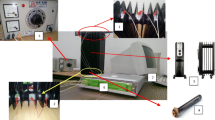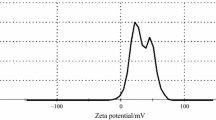Abstract
The influence of dispersing agents of organic (CTAB) and inorganic (sodium pyrophosphate and sodium silicate) nature on the critical heat flux and the heat transfer coefficients during boiling of various water-based nanofluids under free convection has been studied. It has been established that addition of ionic dispersants to aluminosilicate nanofluids, increasing the aggregative and sedimentation stability of the latter, impairs, as a rule, their thermal parameters during boiling causing a sudden precrisis burnout of the heater in the installation powered by direct current. The mechanism of the phenomenon under investigation has been established. It is shown that dispersants and surfactants added to carbon-containing nanofluids with high thermal conductivity, enhancing the stability of the latter, increase, however, the heat transfer coefficient at boiling and cause precrisis burnout of the heater powered by direct current. The influence of dispersants on the crisis phenomena under boiling of water and nanofluids has been analyzed and the causes of sudden precrisis burnout of the heater have been identified. Several mechanisms for interpretation of the effects observed have been proposed. The reasonability of using alternating current for heating and nonionic nonfoaming surfactants and dispersants for prevention of the early onset of the boiling crisis in order to achieve higher values of the critical heat flux and heat transfer coefficient under boiling of nanofluids has been substantiated.








Similar content being viewed by others
REFERENCES
S. K. Das, S. U. S. Choi, W. Yu, and T. Pradeep, Nanofluids: Science and Technology (Wiley, New Jersey, 2007).
W. Yu, D. M. France, J. L. Routbort, and S. U. S. Choi, Heat Transfer Eng. 29, 432 (2008).
S. K. Das, N. Putra, and W. Roetzel, Int. J. Heat Mass Transfer 46, 851 (2003).
H. Kim, Nanoscale Res. Lett. 6, 415 (2011).
D. Zhu, X. Li, N. Wang, X. Wang, J. Gao, and H. Li, Curr. Appl. Phys. 9, 131 (2009).
A. Amrollahi, A. M. Rashidi, M. Emami Meibodi, and K. Kashefi, J. Exp. Nanosci. 4, 347 (2009).
M. J. Assael, I. N. Metaxa, J. Arvanitidis, D. Christofilos, and C. Lioutas, Int. J. Thermophys. 26, 647 (2005).
L. L. Song, R. Y. Zhang, L. B. Mao, W. J. Zhu, and M. Y. Zheng, Appl. Mech. Mater. 71–78, 122 (2011). https://doi.org/10.4028/www.scientific.net/AMM.71-78.122
B. I. Bondarenko, V. N. Moraru, S. V. Sidorenko, D. V. Komysh, and A. I. Khovavko, Tech. Phys. Lett. 38, 853 (2012).
B. I. Bondarenko, V. N. Moraru, S. V. Sydorenko, D. V. Komysh, A. I. Khovavko, and A. V. Snigur, in Proc. 8th Int. Symp. on Heat Transfer, Beijing,2012, p. 181.
B. I. Bondarenko, V. N. Moraru, S. V. Sydorenko, D. V. Komysh, and A. I. Khovavko, Nanosci. Nanoeng. 4, 12 (2016).
E. C. Forrest, S.M. and S.B. Thesis (Massachusetts Inst. of Technology, 2009).
A. V. Minakov, M. I. Pryazhnikov, D. V. Guzei, G. M. Zeer, and V. Ya. Rudyak, Int. J. Therm. Sci. 116, 214 (2017).
A. S. Surtaev, V. S. Serdyukov, and A. N. Pavlenko, Nanotechnol. Russ. 11, 696 (2016).
G. Liang and I. Mudawar, Int. J. Heat Mass Transfer 124, 423 (2018).
D. Milanova and R. Kumar, Appl. Phys. Lett. 87, 233107 (2005).
D. Milanova and R. Kumar, J. Heat Transfer 130, 042401 (2008).
R. Kumar and D. Milanova, Appl. Phys. Lett. 94, 073107 (2009).
R. Kathiravan, R. Kumar, A. Gupta, and R. Chandra, Int. J. Heat Mass Transfer 53, 1673 (2010).
Yu. I. Tarasevich, Structure and Surface Chemistry of Layered Silicates (Naukova Dumka, Kiev, 1988).
V. N. Moraru, Clay Miner. 53, 255 (2018).
A. Adamson, The Physical Chemistry of Surfaces (Wiley, New York, 1976).
V. N. Moraru, N. I. Lebovka, and D. G. Chevchenko, Colloids Surf., A 242, 181 (2004).
B. I. Bondarenko, V. N. Moraru, B. K. Ilyenko, A. I. Khovavko, D. V. Komysh, E. M. Panov, S. V. Sydorenko, and O. V. Snigur, Int. J. Energy Clean Environ. 14, 151 (2013).
B. I. Bondarenko, V. N. Moraru, S. V. Sydorenko, and D. G. Komysh, in Proc. 2nd AMN-APLOC Conf., Singapore,2011, p. 74.
H. Van Olphen, An Introduction to Clay Colloid Chemistry (Wiley, New York, 1977).
S. J. Kim, I. C. Bang, J. Buongiorno, and L. W. Hu, Appl. Phys. Lett. 89, 153107 (2006). https://doi.org/10.1063/1.2360892
S. J. Kim, I. C. Bang, J. Buongiorno, and L. W. Hu, Bull. Pol. Acad. Sci.: Tech. Sci. 55, 211 (2007).
S. M. You, J. H. Kim, and K. H. Kim, Appl. Phys. Lett. 83, 3374 (2003). https://doi.org/10.1063/1.1619206
Q. T. Pham, T. I. Kim, S. S. Lee, and S. H. Chang, Appl. Therm. Eng. 35, 157 (2012).
H. D. Kim and M. H. Kim, Appl. Phys. Lett. 91, 014104 (2007).
H. H. Son and S. J. Kim, Int. J. Heat Mass Transfer 138, 985 (2019).
S. S. Dukhin, V. R. Estrela-Liopys, and E. K. Jolkhovsky, Electrosurface Phenomena and Electrofiltration (Naukova Dumka, Kiev, 1985).
B. I. Bondarenko, V. N. Moraru, S. V. Sidorenko, D. V. Komysh, and N. N. Gudkov, Tech. Phys. Lett. 44, 461 (2018).
D. M. Vazquez, S.M. Thesis (Univ. of Central Florida, Orlando, 2008).
Funding
This work was supported by the Support for the Development of Priority Research Areas Program, project no. KPKVK 6541230.
Author information
Authors and Affiliations
Corresponding author
Ethics declarations
The authors state that they do not have any conflicts of interest.
Additional information
Translated by O. Lotova
Rights and permissions
About this article
Cite this article
Moraru, V.N., Bondarenko, B.I., Sidorenko, S.V. et al. Nanofluids for Power Engineering: The Mechanism of the Influence of Dispersing Agents on the Thermal Parameters and Crisis Phenomena during Boiling. Tech. Phys. 65, 163–173 (2020). https://doi.org/10.1134/S1063784220020140
Received:
Revised:
Accepted:
Published:
Issue Date:
DOI: https://doi.org/10.1134/S1063784220020140




